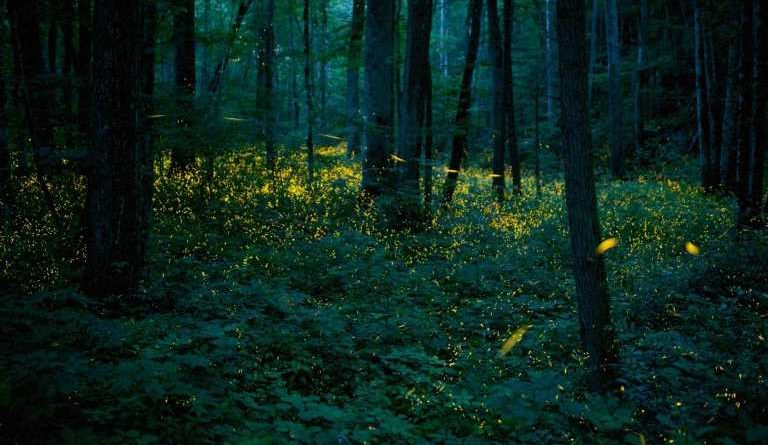See fireflies magically light up this national park
Every spring, the twinkling lights from thousands of fireflies illuminate the forests of Elkmont, Tennessee, located in the Great Smoky Mountains National Park. Together, the fireflies glow in a series of synchronous bursts before plunging everything into darkness—a pattern that repeats for hours as the fireflies search for their mates.
“Seeing these fireflies for the first time is magical,” says Orit Peleg, a physicist at the University of Colorado Boulder who studies synchronous fireflies. “The entire forest is flashing together in unison.”
Synchronous fireflies are just one of 19 species of fireflies that live in the Smokies—but they have become a major draw. Every year, the National Park Service hosts an eight-day event at the peak of mating season, which typically lasts about two weeks around the end of May or the beginning of June. The festival has become so popular that the park has established a lottery system to win tickets. Last year, the event was canceled due to the pandemic and plans have not yet been announced for this year.
What makes synchronous fireflies so dazzling that thousands of tourists come to see them each season? Here’s what makes these fireflies unique, how to see them in action (even if you don’t score tickets), and the important role that visitors play in protecting these captivating creatures.
Nature’s light show
The synchronous fireflies were more a local curiosity than a tourist sensation when entomologist Becky Nichols began working at the Great Smoky Mountains National Park in 1997. But with the rise of social media, word got out. These days, there are about a thousand people out on the trail each night—all watching the spectacle in silent awe.
Load Error
That’s because these are not your average lightning bugs that brighten up backyards around the world with their bioluminescent lanterns. Out of more than 2,000 firefly species in the world, only about a dozen can coordinate their flashes, including Smoky Mountains’ synchronous species, Photinus carolinus.
These glow bugs share the same basic biology as other species. Fireflies—which are a type of beetle—have organs under their abdomens that combine oxygen with a chemical called luciferin to produce a yellow, green, or even blue glow. But each species has a unique flashing pattern that plays an important role in firefly courtship, helping individuals identify their mates.
(These mysterious fireflies synchronize their dazzling light in Mexico.)
The blinking display for these synchronous fireflies can seem random at first, Nichols says. Unlike other synchronous species that flash continuously, male Photinus carolinus fireflies light up in a series of four to eight rapid bursts then go dark all at once. As more males join a swarm, the flashing grows faster and with greater synchrony.
“Then it can really look like this pulsating flash pattern,” Nichols says. “It looks like a wave that goes up the hill. That’s when it really gets magical.”
Video: Skiing and Riding Snowmobiles Are What These Squirrels Love Doing The Most! (Buzz60)
A New Tool Could Help You Dodge Possible COVID Hotspots!
Buzz60
Skiing and Riding Snowmobiles Are What These Squirrels Love Doing The Most!
Buzz60
Cat Cavity! A Curious Cat Survived Being Stuck in the Cavity of a House for 3 Weeks!
Buzz60
Your Daily Reminder to Brush Up on Your Self Defense Skills
Buzz60
Operation Population! Argentinian Park Hopes To Increase Jaguar Population in Area!
Buzz60
Prince Charles is Now "King in Training'
Buzz60
The Queen Has Two Birthdays…Here’s Why
Buzz60
Queen Elizabeth To Change This Tradition Following Her Husband's Death
Buzz60
Life-Changing Laundry Tips You’ll Never Want to Forget!
Buzz60
Jelly Bean Blast! You Could Win Big on National Jelly Bean Day!
Buzz60
Three in Five Women Have No Idea What Products and Ingredients Are Put Into Tampons
Buzz60
The Average American Would Spend Up to $7,000 To Be Able To Travel Again
Buzz60
Whole Bean Coffee or Ground Coffee? Let’s Break It Down
Buzz60
Kate Middleton Pays Tribute to the Queen and Prince Philip by Wearing One of the Queen’s Pearl Necklaces
Buzz60
An Educational Rodent Named Justin Beaver Is Going Viral!
Buzz60
Do Cheesy Pickup Lines Actually Work?
Buzz60
A New Tool Could Help You Dodge Possible COVID Hotspots!
Tripadvisor along with other tech companies just released a new tool that help’s travelers avoid crowded areas while traveling. Buzz60’s Lenneia Batiste has more on this new platform.
Buzz60
Skiing and Riding Snowmobiles Are What These Squirrels Love Doing The Most!
These squirrels were caught making the most of the winter weather! They were captured posing on miniature skis and snowmobiles! Buzz60’s Maria Mercedes Galuppo has the story.
Buzz60
Cat Cavity! A Curious Cat Survived Being Stuck in the Cavity of a House for 3 Weeks!
Three weeks might be a long time and for this cat, it certainly was as she got stuck in the cavity of a house for that long. Buzz60’s Mercer Morrison has the story.
Buzz60
Once enough males are flashing in the swarm, mating can begin. In the brief periods of darkness between bursts, female fireflies respond from their perch on the ground. With two quick flickers, they let the males know where to find them.
Peleg says no one knows for sure why the fireflies behave this way. Synchronizing their flashes may help males amplify their signal to females that are farther away, or it might provide safety from predatory firefly species that mimic other species’ flashing patterns to lure their prey. The theory, she says, is that “swarms would be more successful collectively.”
But the window to see the firefly display is a brief one. Mating season for Photinus carolinus typically lasts about two weeks around the beginning of summer when evening temperatures in the forest have risen above 50 degrees.
Why they need protection
Even as the popularity of firefly tourism booms in places like the Smokies, fireflies are declining around the world—forcing the National Park Service to put in place measures to protect them.
“It is a gateway to the miraculous,” says Sara Lewis, a biology professor at Tufts University who was part of an international working group that established conservation guidelines for firefly tourism. “But the dark side is that you get tens of thousands of people that descend on the Smokies in a typical season.”
For fireflies, mating and conservation efforts are intrinsically linked. Fireflies stop flashing when they’re exposed to bright light pollution, which not only disrupts the mating process but can consequently lead to fewer fireflies in future generations.
Meanwhile, overwhelming crowds can also cause real harm. When people traipse across or set up chairs on top of a firefly habitat, it can kill not only the flightless females on the forest floor but also their larvae that are developing in the ground.
(A rare look at fireflies that blink in unison, in a forest without tourists.)
“It’s an amazing experience so you want to walk out into the forest where there aren’t so many people and lay down,” Lewis says. “But you’re laying down on top of firefly larvae.”
To cut down on light pollution from the parking lot, the park runs trolleys from the Sugarlands Visitor Center to Elkmont and distributes red-light flashlights to lottery winners. (Nichols says fireflies don’t respond as much to red light.) The lottery itself helps the park keep the number of visitors each night in check.
How to see the fireflies
So what happens if you’re lucky enough to win the lottery? After grabbing a trolley to the Elkmont viewing area, be prepared to practice good firefly etiquette. Stay on designated trails and either turn off your cell phone or cover its light with red cellophane.
Nichols recommends setting up chairs in clear areas along the trail to get a better view of the lightning bugs. Park employees can also offer advice on where to watch and tell you more about the phenomenon you’re seeing.
The synchronous fireflies typically start to come out around 9:30 p.m.—“It’s like clockwork,” Nichols says—and, within two hours, the swarm is likely to be as big as it’s going to get that evening.
If you don’t score tickets, though, there’s still hope. Nichols suggests visiting Elkmont a few days just before or after the festival as the swarm is still likely to be in action. You could also look for them in other areas of the park with small clearings where fireflies would be able to see one another and with moist leaves on the ground where their pupi can develop.
“You really have to turn off all the lights and just watch,” Nichols says. “We’ve discovered areas of the park where we didn’t know the synchronous fireflies were just by doing that.”
Lewis says she hopes visitors won’t just be dazzled by the synchronous fireflies but also motivated to help save them for generations to come.
“Don’t just walk away,” she says. “Think: Do you want to live in a world where this experience is lost to your grandchildren or is this experience worth preserving?”
Source: Read Full Article




















